Here’s your Friday fold:
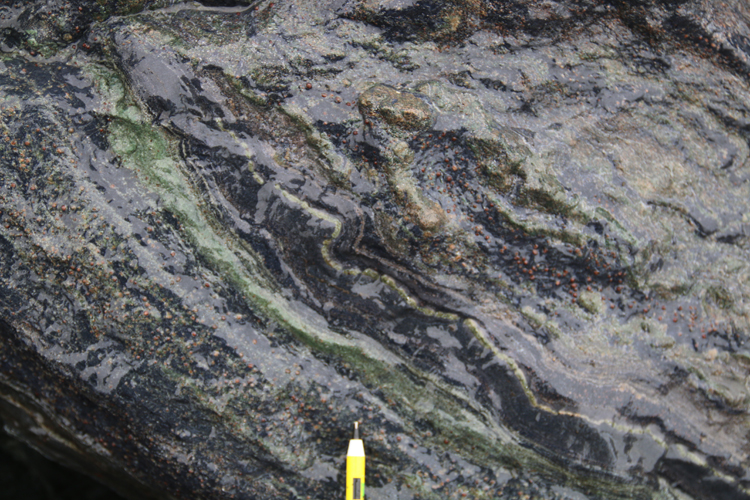
Let me explain. Like ~25,000 of you, I spent much of the past week in San Francisco, at the AGU Fall Meeting.
I headed out one day early, to capitalize on an opportunity to take a trip up to Jenner, California, to check out some cool metamorphic rocks on the coast there. My guide was Dexter Perkins, mineralogist and petrologist of the University of North Dakota. Dexter drove me up to the right place, but the weather wasn’t really cooperating:

Oh well, we’d come all this way: I guess we were going to get wet.
The resistant protrusions you see along the coast at Jenner poke out of the sand as well as the surface, and showcase truly wonderful rocks. Here’s a view of one of these outcrops, sticking out of the sand where the Russian River flows into the Pacific. Note also the birds (white things in the background): approximately the same number here as there were geophysicists at the Moscone Center a couple of days later!
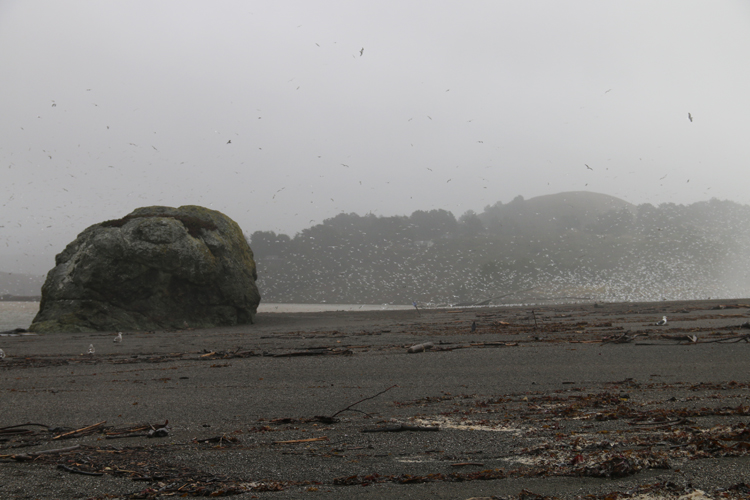
This particular boulder is a relatively low-grade meta-basalt: it’s been altered to greenstone, but still preserves some primary igneous features. Here are two examples of well-preserved lava pillows in the greenschist-facies boulder:

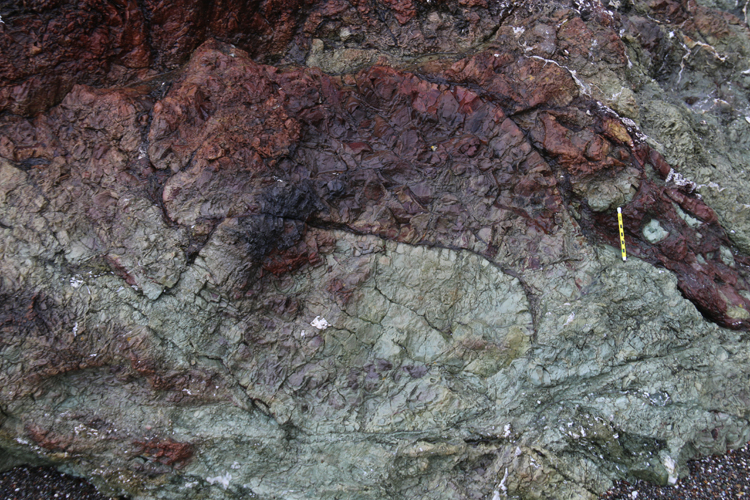
There was more to be seen here, but we weren’t able to get to all the good stuff. For instance, this boulder of what appears to be mixed metamafic (green) and metapelitic (gray) mélange:
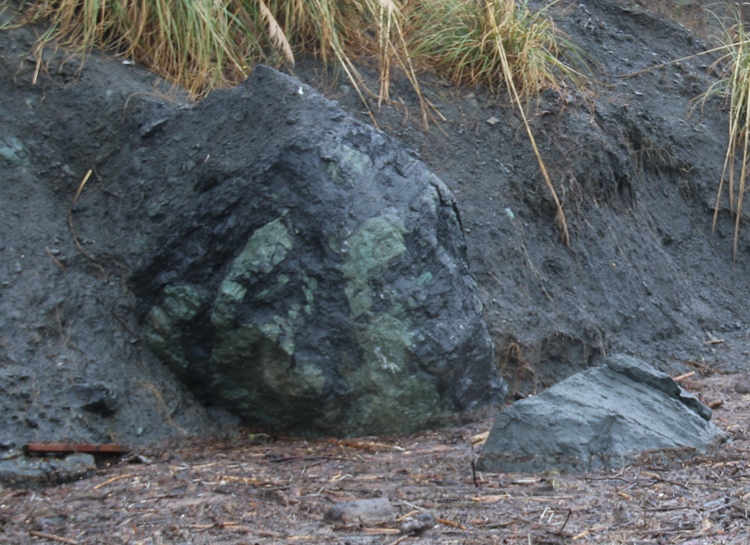
We couldn’t get to it because it was not quite low tide. The Russian River was thus backed up and covered in flotsam. That didn’t stop Dexter from trying to balance on floating logs to get to it (without success):

The muddy cliffs appeared to be dominated by metasedimentary mélange, with clear lozenges of graywacke in what appeared to be a shaley matrix. Here’s a chunk of the sandstone:
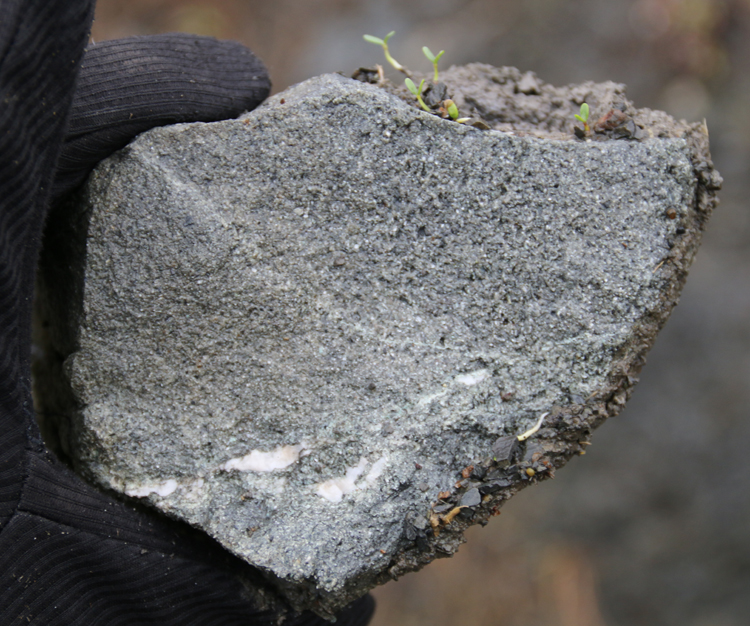
But the real attraction of the outcrops at Jenner are the high-grade subduction-related metamorphic rocks: blueschist and eclogite. Unfortunately, all my photos of these lovely rocks are sopping wet, leading to a lot of glossy glare… Still, the colors are something else:

Blueschist, as the name implies, is blue. The rock is blue because it has blue minerals in it: glaucophane and lawsonite. It’s a meta-basalt that recrystallized at high pressure but relatively low temperature. Because rocks are relatively poor conductors of heat, lithosphere can be subducted at a rate faster than it can thermally equilibrate to surrounding warm rock. This gives subduction zones a unique metamorphic signature: high pressure and low temperature are the conditions you need to get ~200° to ~500° C and depths of ~15 to ~30 km. Eclogites are meta-basalts, too, but they have been even further “down the subduction hatch:” perhaps ~45 to 60 km depth) with temperatures of 400° to 1,000° C. They have their own distinct color scheme: like a Christmas tree, with red garnet and green omphacite.
You can see both at Jenner, which is just about mind-blowing: that these rocks have been SO FAR down into the planet, and yet somehow, in spite of their density, made it back to the surface where lucky Subduction Pilgrims like myself could visit them and get to know them.
Here’s a diagram my colleague Christie Rowe drew up to explain blueschists for a stop on our new digital field guide to the geology of Angel Island, part of the Streetcar 2 Subduction project that we launched at Fall Meeting:
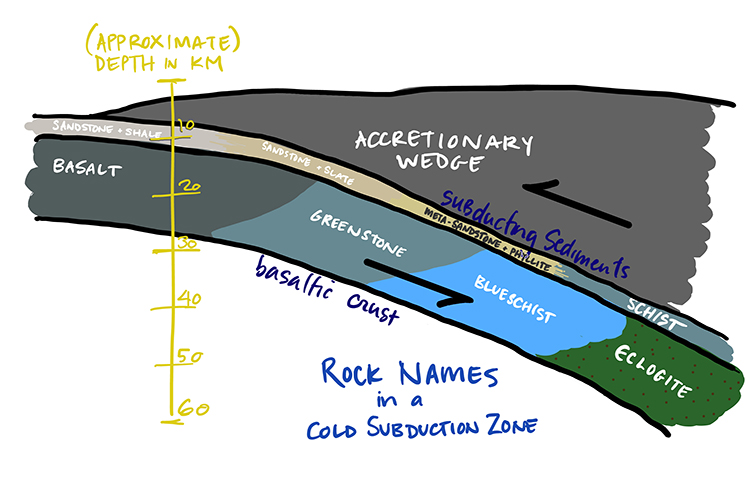
There’s really no precise cut-off between the two metamorphic facies, since the presence or absence of water will have a critical role in determining whether metamorphic reactions can proceed efficiently.
The blueschists at Jenner are unique in my experience, because they feature quite a lot of garnet.

This garnet’s presence in the blueschist is cited as evidence that these rocks were once all eclogite, and then some of them retrograde-metamorphosed to blueschist on their way back up to the surface.
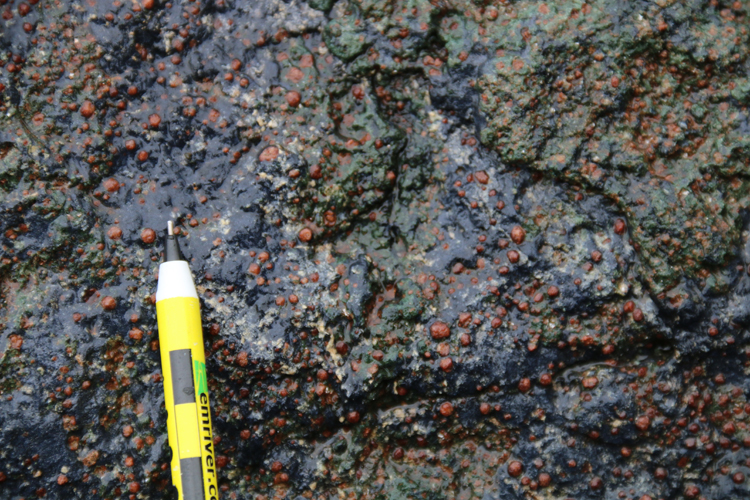
Layering of blueschist layers relative to greenschist layers was a key feature of one boulder:

These cm-scale stripes are a little surprising – it’s not as if the green slices have been down to eclogite-inducing depths, but the blue ones haven’t. Something else is controlling the situation here, probably water, perhaps percolating along fractures in the meta-basalt.

It was in this one that the fold (that started this post) appeared:

I resolve to get back to Jenner when the weather’s more conducive to careful study of these intriguing rocks.
In the meantime, the AGU Fall Meeting was a big success, and I look forward to next year’s gathering, as well as the associated field trips! Happy weekend to you, and if you’re still in San Francisco, have a safe journey back home.

Awesome post! I am intrigued by the metamorphism that occurs as the sediments are subducted under the overlying plate. Which begs the question: how does the geology change along the subduction zone that runs along the west coast of North America, and does the change in geology play any part in the magnitude and frequency of subduction zone earthquakes?
I could only find one image in a quick search on Google that shows the Cascadia Subduction Zone extending all the way along British Columbia’s west coast (my home) and through down to Jenner, CA. Which links back to the question above – and by no means am I expecting an answer here. Just so fascinating to think about.
Always such a pleasure learning new things while following your blog 🙂
Hi Charlie,
Yes, changes in geology can plausibly play a role in allowing earthquakes or not. Weak rocks (such as talc-rich soapstone or slippery serpentinite) cannot accommodate much stress before slipping, which means that they release their tectonic stresses in frequent small earthquakes or else in continuous aseismic slip.
The subduction zone recorded in the rocks at Jenner was active during the Mesozoic, but is not active today. The modern subduction is not all “along the west coast of North America,” but is restricted to two distinct localities; (1) the Cascadia subduction zone from Cape Mendocino in way northern California to the British Columbia border (this is the subduction of the Juan de Fuca Plate; north of that is the Queen Charlotte Fault: a transform plate boundary), and (2) the subduction of the Cocos Plate beneath southern Mexico and Central America. In between, in the modern day, we have a transform plate boundary: the San Andreas Fault and the oblique transtension beneath the Gulf of California.
CB
Despite the wet glare, these are spectacular photos of very cool rocks – many thanks!
Glad you enjoyed.
Any chance you might let us know a little more specifically where the blueschist and greenschist were located so we might see them next summer? For example, north or south of the river? Thanks.
Hi Gary,
North of the river, immediately up against the base of the cliff, is the best spot for collecting if it’s not covered in sand (as it apparently is for most of the winter).
There are large protuberant boulders poking up through the sand further out, but those shouldn’t be sampled – they are classics that can be visited in all seasons.
C
Great info. Thank you.
Really loved the post and the explanation. Many thanks!
Not a geologist, but someone explained eclogite to me last year, and now I’m all excited to go see some in person. I’m heading up the coast this weekend and specifically making a point to stop in Jenner to see this rock. Found this blog post in a google search, and will use it as a guide. Thank you very much for the photos and descriptions.
There’s really excellent eclogite in Cazadero, a small town east of Jenner that’s easy to get to. There are other outcrops that are much more difficult to get to